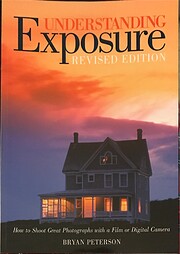

Auf ein Miniaturbild klicken, um zu Google Books zu gelangen.
|
Lädt ... Petersons Fotoschule: Der Einstieg. Mit der richtigen Belichtung zum besseren Foto (2004)von Bryan Peterson
 Keine aktuelle Diskussion zu diesem Buch.   ) )After just having read "The Photographer's Eye", a book so dense I couldn't consume more than four pages or so per day, I started "Understanding Exposure"—and read it in just a couple of days. Not because I liked it so much, but because it just didn't contain that much information. The author is implicitly assuming that your main goal is slow-paced, methodical landscape photography. He literally scoffs at you for not carrying your tripod everywhere, for not using a full-frame camera, or for using any kind of automation. If you're not shooting everything in manual, at base ISO, you are not a real photographer, he seems to say. So take out your light meter, go to manual exposure, and switch off your autofocus, or this book is probably not for you. It was certainly not for me. As an amateur, I don't have infinite time to set up the perfect shot, and wait for the perfect dawn light. I even like to—gasp—use auto-ISO, -focus, and -white balance. There is a lot of good information, and practical wisdom in this book, if you can read between the lines, ignore scores of irrelevant descriptions of camera settings, and generally translate knowledge from the film days to your modern camera. I just wish it were updated to account for modern technology, and didn't come off quite as condescendingly as it does. Like many readers I already knew about 70% of this book. Still...I was mostly interested in metering and the zone theory. The zone theory isn't discussed in detail but is covered somewhat in the more advanced parts of exposure. I thought he had a lot of great tips. I had heard them mentioned but his explanation and examples have help me understand better how to do them and I have been able to put them into practice quickly. I read this quickly and found it helpful, I've had this book several years yet hadn't delved into it. I'm glad I did. After reading this book, I am inspired to understand "creative exposure" better as well as learn the different features of my camera, which my husband bought me a year and a half ago. I still have a lot more to learn about concerning when to use specific lens, how to show depth of field in my pictures and many more things but this book steered me jn the right direction. The author shared quite a bit of helpful information, and I think many folks interested in improving their photography would benefit from this book. keine Rezensionen | Rezension hinzufügen
Veteran photographer Bryan Peterson demystifies complex concepts of exposure in photography by explaining the fundamentals of light, aperture, shutter speed, and how they interact with and influence one another. This book explains how to get or lose sharpness and contrast in images, freeze in action, and take the best meter readings while also exploring filters, flash, and light. This forth edition includes all new images as well as an expanded section on flash, tips for using colored gels, and advice on shooting star trails. Keine Bibliotheksbeschreibungen gefunden. |
Aktuelle DiskussionenKeineBeliebte Umschlagbilder
 Google Books — Lädt ... Google Books — Lädt ...GenresMelvil Decimal System (DDC)771The arts Photography, computer art, cinematography, videography Techniques, equipment, materialsKlassifikation der Library of Congress [LCC] (USA)BewertungDurchschnitt: (4.21) (4.21)
Bist das du?Werde ein LibraryThing-Autor. |
||||||||||||||||||||||||||||||||||||||||||||||||||||||||||||||||||||||||||||||||||||||||||||||||||||||||||||||||||||||||